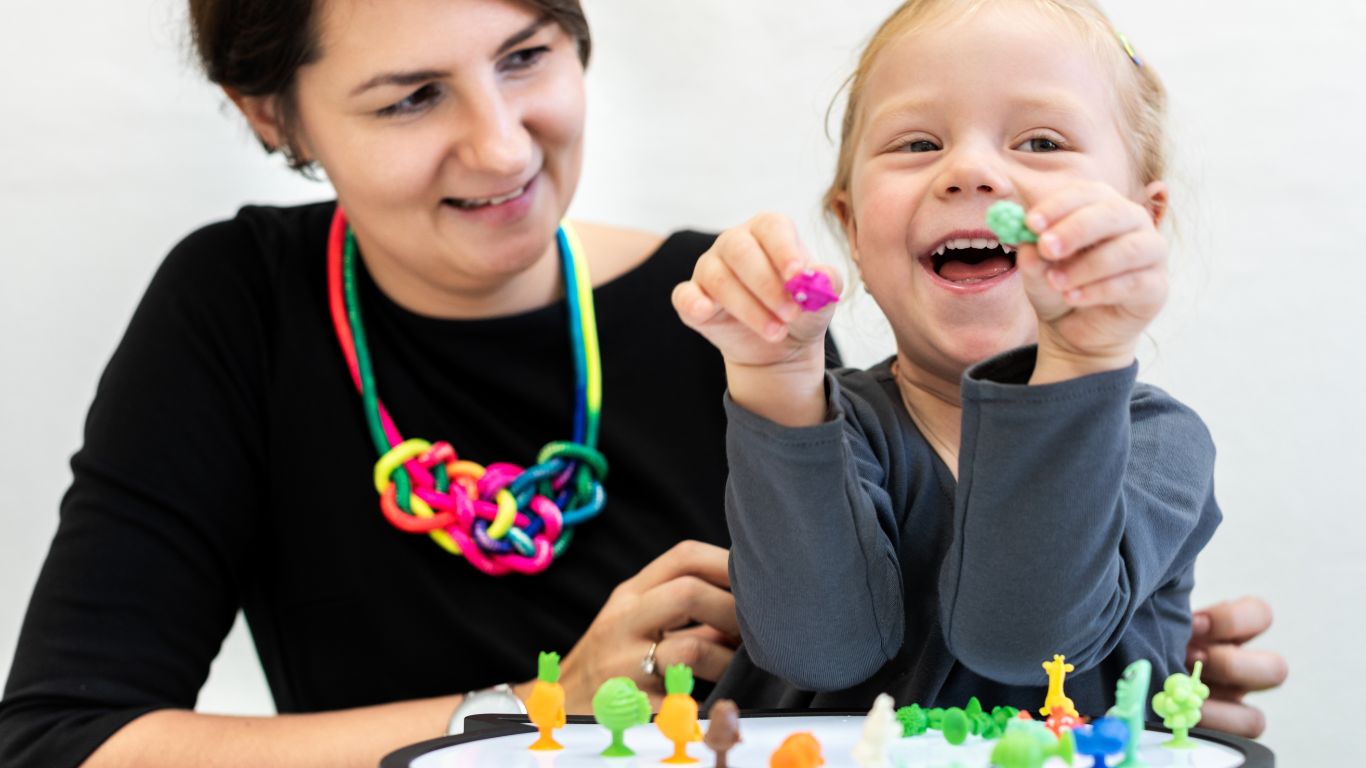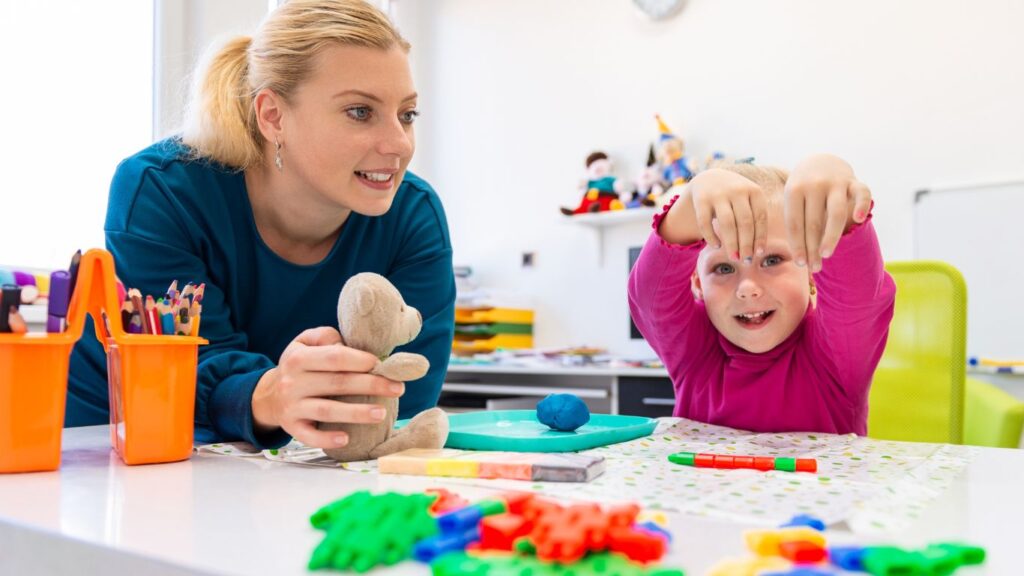Did you know that one in six kids faces developmental challenges that can affect how they learn, play, and connect with the world around them? For many families, navigating these challenges can feel overwhelming and uncertain, but there’s hope.
Occupational therapy for children offers a path forward by helping them build the skills they need to thrive in everyday life. Whether improving coordination, enhancing social interactions, or fostering independence in daily tasks, pediatric OT provides targeted support that empowers kids to reach their full potential.
It’s not just about the child. Addressing these challenges early and effectively with child development support helps build a brighter, more confident future for kids and their families.
Get Started with Occupational Therapy Today
Signs Your Child May Benefit From Occupational Therapy
Trusting your instincts as a parent is important, especially when it comes to your child’s development. If you’ve noticed certain behaviors or challenges that seem a bit out of the ordinary, it might be worth exploring occupational therapy.
Here are ten signs to help you understand if your child could benefit from extra support:
Struggles with Fine Motor Skills

Fine motor skills involve small, precise movements that help children do everyday tasks like holding a pencil, buttoning clothes, or using utensils. School and home activities can be harder when kids struggle with these skills.
For example, a poor pencil grip might make writing or drawing frustrating, leading to messy handwriting or a lack of interest in creative activities. Difficulty with utensils can also make mealtimes more challenging.
Fine motor delays can happen for many reasons, like weak muscles, poor coordination, or sensory challenges. Research also shows that early intervention can make a big difference. Occupational therapists use targeted activities to help kids improve their motor skills, making tasks like tying shoes or cutting with scissors easier and more enjoyable.
Sensory Processing Issues
Sensory processing issues occur when the brain has difficulty understanding or responding to sensory input from the world around us.
For some kids, everyday things like noises, textures, lights, or movements can feel overwhelming or confusing. This can cause sensory overload, where everything feels too intense, or sensory seeking, where someone craves more stimulation to feel balanced.
Children with sensory processing challenges might have meltdowns in noisy environments, avoid certain foods because of their texture, or constantly move, like spinning or jumping.
Sensory integration therapy can help. Using fun, play-based activities tailored to the child’s unique needs, occupational therapists work to help the brain process sensory input more smoothly.
Difficulty with Daily Routines
Children with sensory processing differences often find everyday tasks overwhelming.
Simple activities like brushing teeth, tying shoes, or staying organized can feel stressful because their brains process sensory input differently. Even small textures or movements can feel uncomfortable.
For example, a child sensitive to touch might avoid brushing their teeth because the toothbrush or toothpaste feels unpleasant. Tying shoes can also be frustrating if fine motor skills or focus are a challenge.
Research shows these self-care struggles are common. According to The American Journal of Occupational Therapy, many kids with sensory processing issues take longer to develop skills for daily routines like dressing, eating, or brushing their hair. Textures, fasteners, and even food sensations can create extra challenges, leading to delays.
OT uses step-by-step strategies to make these tasks easier. For example, our team of OT therapists may introduce desensitization techniques to reduce discomfort or break tasks into smaller, manageable steps.
Get Started with Occupational Therapy Today
Missed Developmental Milestones

Developmental milestones help track a child’s growth, like how they move, communicate, and interact with the world. But not every child follows the same timeline.
Missing a milestone may simply mean they need a little extra support. For example, by age 3, most children can stack six blocks, which is an activity that requires hand-eye coordination, fine motor skills, and problem-solving.
If a child struggles with milestones like stacking blocks, crawling, walking, or speaking, occupational therapy (OT) can help close the gap. OT uses fun, play-based activities tailored to each child’s needs to help them practice important skills.
For instance, if a child is walking or speaking later than their peers, OT works to strengthen these areas. Activities like stacking blocks or solving simple puzzles aren’t just games, they’re tools to build coordination, focus, and muscle strength.
Also, milestones like these aren’t just about progress; they’re about fostering independence and confidence in everyday life.
Get Started with Occupational Therapy Today
Behavioral or Emotional Outbursts
Frequent tantrums or emotional overwhelm may signal a child is struggling with emotional regulation. These outbursts can stem from frustration, sensory challenges, attention difficulties, or anxiety. For children with autism or pathological demand advoidance, these episodes often arise due to differences in processing stimuli and emotions.
Occupational therapy (OT) is a valuable tool for teaching self-regulation skills. Sensory-based interventions help kids manage sensory overload, reducing meltdowns and fostering calm responses.
Plus, emotional regulation exercises improve focus and help handle frustration. OT also discovers what a child’s behavior may be communicating, offering tools like emotional cue cards, calming techniques, and routines to support healthier expression.
Applied Behavior Analysis (ABA) therapy often complements OT, combining emotional and social skill-building with sensory regulation. Parents play a vital role, using therapist-guided strategies to create calming environments and recognize triggers at home.
With time and support, kids can improve emotional regulation, reduce outbursts, and build resilience.
Get Started with Occupational Therapy Today
Poor Social Interaction Skills

Struggling with social interaction is a common challenge for many kids, especially those on the autism spectrum. This can show up as difficulty making friends, avoiding eye contact, trouble understanding social cues, or issues with sharing and taking turns during play.
For some, these challenges are characteristic of social pragmatic language disorder. They stem from difficulties recognizing emotions, reading facial expressions, or responding appropriately in social situations.
The good news? Early intervention and targeted therapies can help. Social skills therapy, often part of occupational therapy (OT) and ABA therapy, is designed to build these essential skills in a structured, supportive way.
Therapists use fun and practical activities like role-playing to teach children how to hold conversations or play-based exercises to practice sharing and turn-taking.
Avoidance of Physical Play
Some kids avoid physical play because they struggle with balance, coordination, or gross motor skills. These challenges can make activities like running, jumping, or climbing feel difficult or even scary.
For example, a child with poor balance might feel unsure on climbing structures or during fast-paced games, making them hesitant to join in playground fun. This can lead to a fear of outdoor group activities, as these situations may highlight their struggles.
Occupational therapists (OTs) can make a big difference for kids facing these challenges. They focus on activities that strengthen core muscles, improve coordination, and boost balance.
OTs can also help kids build the skills they need through engaging exercises. Obstacle courses, hopping games, or playing with a yoga ball are great ways to boost confidence and physical ability over time.
With the right support, kids can overcome clumsiness and gain the enthusiasm to join in physical play. This not only improves their physical health but also helps them connect with peers, feel included, and enjoy group activities without fear.
Handwriting Challenges

Handwriting struggles can affect a child’s success at school. Issues like messy writing or poor letter formation can make it hard for kids to express their ideas.
One common cause is dysgraphia, a condition that affects fine motor skills needed for writing. Signs of dysgraphia include trouble holding a pencil, uneven spacing, and slow writing. These challenges can leave kids feeling frustrated and less eager to participate in class or social activities.
Thankfully, occupational therapy (OT) offers effective support. Studies show that OT improves handwriting in children.
Therapists use hands-on activities like tracing, drawing, and using special tools to strengthen motor skills, improve pencil grip, and teach clearer letter formation
Get Started with Occupational Therapy Today
Extreme Picky Eating
Extreme picky eating goes beyond just being fussy. It can affect a child’s nutrition, growth, and well-being.
Often linked to oral sensory issues, it can make new textures, tastes, or even the sight or smell of certain foods overwhelming. For some kids, eating feels stressful because their brain processes textures and tastes differently, making mealtimes a challenge.
Occupational therapy (OT) coupled with feeding or nutrition therapy can make a big difference for children struggling with oral sensory issues. Therapists use gentle, step-by-step approaches tailored to each child’s sensory needs.
For example, they might start by helping kids explore new foods by looking, touching, or smelling them before moving on to tasting. These techniques help kids feel more comfortable trying new foods and overcoming food-related anxieties.
Difficulty Transitioning Between Tasks
Transitioning between tasks can be tough for many kids. This is especially true for those who rely on routine and consistency.
It is often called transition challenges and is common in kids on the autism spectrum. Changes like stopping playtime for dinner or starting a new school can feel overwhelming. These situations can lead to anxiety, meltdowns, or resistance.
Studies show that these struggles often cause anxiety or difficulty adapting. Some kids also have trouble understanding time and sequence.
Occupational therapy (OT) can help kids navigate these challenges. It can make transitions easier. Therapists use tools like visual schedules, timers, and social stories. These tools create structure and help reduce anxiety.
Parents can support this process at home. Introducing transitions slowly can help. Using clear cues like verbal warnings or visual aids is also beneficial.
Not to mention, parents can show kids that change can be a good thing. With the right strategies and teamwork between families and therapists, kids can build the skills they need.
They can handle transitions with more certainty. This reduces stress and improves daily life.
Get Started with Occupational Therapy Today
What Is Pediatric Occupational Therapy?
Pediatric occupational therapy helps kids build the skills they need for everyday life. It focuses on two main areas: fine motor skills such as writing or buttoning shirts, and gross motor skills such as running, jumping, or balancing.
OT also supports sensory processing, helping kids handle things like loud sounds, bright lights, or different textures.
The goal?
To help children become more independent and confident in tasks at home, school, and play. With personalized care plans, therapists work closely with each child to help them reach their own unique milestones in a supportive way.
FAQs
Have questions? We at The Clubhouse are happy to provide answers and further information about our occupational therapy services.
What Age Is Best for Occupational Therapy?
Occupational therapy can benefit individuals of all ages. For children, starting early, often during the preschool years, can help address developmental delays or challenges more effectively.
How Long Does OT Take to See Results?
The timeline varies depending on the child’s needs and goals. Some may see progress in weeks, while others may require months of consistent therapy.
Does Insurance Cover Pediatric OT?
Many insurance plans cover pediatric occupational therapy, but coverage depends on the policy and the medical necessity of the therapy. Always check with your provider for details.
Get Started with Occupational Therapy Today
Verdict: How Early Intervention Could Save Your Child’s Future?
Starting therapy early can make a huge difference in helping kids overcome challenges and thrive. It can boost motor skills, morale, and autonomy. Acting early helps unlock your child’s potential.
If you notice any signs, talk to an OT and give your child the tools they need to succeed!

